





 |
 |
 |
 |
 |
 |
| Andrys Basten | profile | all galleries >> TURKEY Photos - Anatolia, 2004, with Canon Elph >> Gaziantep photos, mosaics - Zeugma (Belkis) | tree view | thumbnails | slideshow |
| Zeugma is the name of the now flooded old city that held the Roman villas with the tile mosaics and which was the most important Roman outpost at that time. So, these are essentially Zeugma photos. See PBS's NOVA: Lost Roman Treasure transcript. |
|
As in Antakya, the Gaziantep Museum (see also the museum's own web site), exhibiting the Zeugma discoveries, was closed when we got there but our guide Aytuk phoned the mayor's office and got us in regardless with, again, another few-minutes sprint (5 minutes this time) through a fine museum, but at least we were able to see, at all, some of the beautiful finds
in both museums. On the net is a drama-filled letter addressing a controversy over handling and moving of mosaics from Gaziantep to a temporary exhibition in Istanbul -- and, in May 2004, an article that explains 1) the incredible story of finding the mosaics and sculpture just before the old city of Belkis / Zeugma was to be flooded for a dam and the rush to retrieve the beautiful, well-preserved artwork (protected by several layers of clay in the past) and 2) the political tug of war that has gone on since and which Packard was addressing in detail in his letter.
Also online: |
|
Gaziantep is one of the more modern provinces of the southeast region of Turkey and
also one of the oldest of Hittite origin (1700's BC); moreover, stone tools were
found in Dülük cave, the history of these tools going back 600,000 years, to
the Paleolithic Period. It's also the largest city in that region and the 6th largest in all of Turkey. More important :-) , it's considered by some as making the best baklava in the world. It was called Hamtap during the middle ages, and after it was absorbed into the Ottoman Empire in the 16th century (after centuries of one civilization overtaking another, as was common in the sought-after crossing-point areas which are a major part of Turkey), it was called Ayintap for 'Good Spring'...
In 1919-1921 it was known as the center of resistance to European takeover,
and when Ataturk returned it to Turkey in 1922, he renamed it in honor of the
city's heroic efforts: |
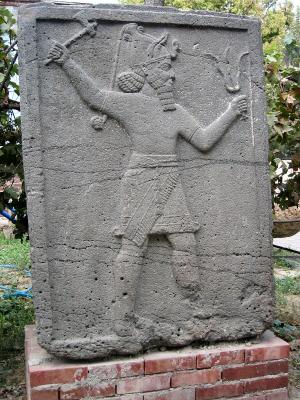 Bas-relief of Teshup, one of the major Hittite gods This not-minor relief is on display out in the garden. Nicely done garb. |
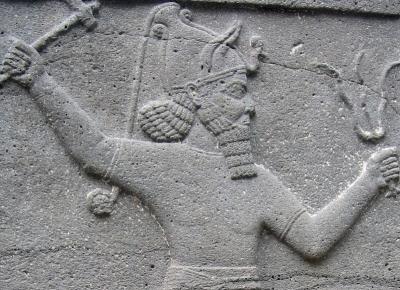 Detail from photo. |
 Front garden has stelae with reliefs made of basalt depicting Hittite Period funeral banquets |
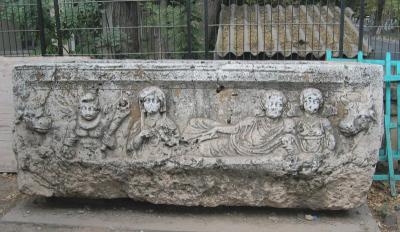 One of 4 Roman Period sarcophagi displayed in the back garden. Almost gothic-horror style... |
 Eagle motif representing the Roman Period man and wool basket motif representing the woman As described at an Adiyaman site, this was in the side garden. |
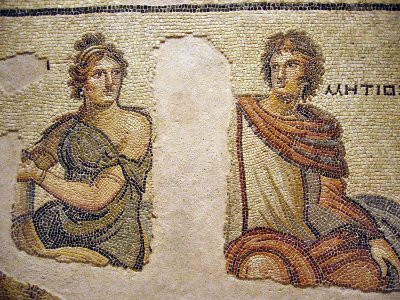 Stolen but found Parthenope and Metiochus ( Metiokhos ) The Romeo and Juliet of the ancient world. This section was stolen from the main piece at Zeugma,
|
 5' statue of Mars (Ares) from a Roman Villa at Belkis / Zeugma. No flash (5 minutes given us in the museum w/o flash or tripod meant no zoom lens in this dark room.)
|
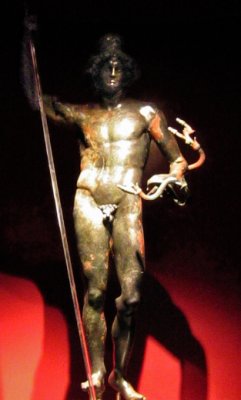 Mars ( Ares ) from center of photo. 1/10th sec exposure. No flash allowed. He was found among storage jars in the larder of a villa ! but had his own room in 2004. :-)
|
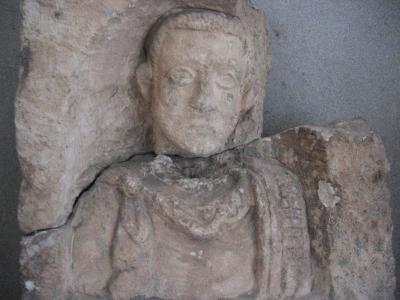 A poignant sculpture from a villa, seen in PBS Nova special This expressive piece is in the Belkis / Zeugma Hall (thin, long corridor) and was probably found
|
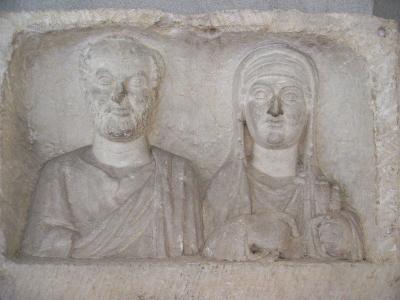 A couple, in the Belkis / Zeugma Hall in the museum I took this photo because out of all the basalt stalae reliefs there, many of couples, this
|
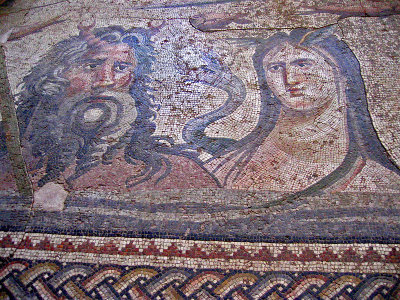 Floor Mosaic - Oceanus ( Okeanos ) and Tethis ( Tethys ) Double lobsters are tied to his hair while Thetis has double wings on her head. The river
|
 Museum keeper next to "Birth of Aphrodite" mosaic We were at first not allowed, of course, into a closed museum, but our guide Aytuk called the mayor's
|
| comment | share |
| danielle rigby | 19-Jun-2009 07:04 | |
| sine | 18-Dec-2008 08:06 | |
| Sonia D Harlan | 13-Aug-2008 07:54 | |
| erliza | 19-Aug-2006 15:25 | |
| katlyen g | 02-Dec-2005 19:35 | |
| döne | 02-Dec-2005 09:42 | |
| hasan | 19-Oct-2005 10:27 | |
| Hus | 17-Oct-2005 10:28 | |
| Andrys Basten | 29-Sep-2005 05:33 | |
| Andrys Basten | 29-Sep-2005 05:09 | |
| hus | 28-Sep-2005 23:08 | |